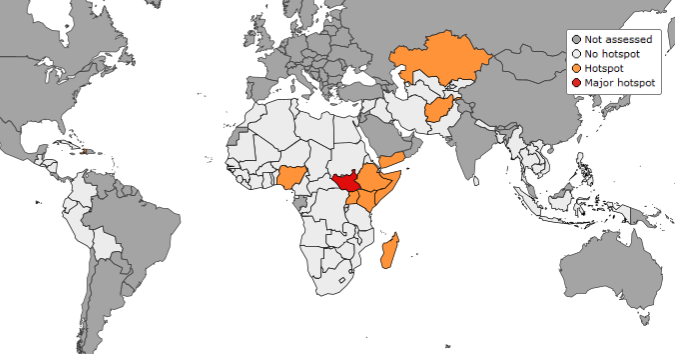
ASAP hotspot assessment September 2021
© ©European Union, 2021
The September edition of the JRC's Anomaly Hotspots of Agricultural Production (ASAP) assessment is now available at: Anomaly Hotspots of Agricultural Production (ASAP) assessment
Main findings of the September global overview:
- In Southern Africa, the main season has ended with a bumper summer cereal output (23% above the 5-year average (FAO)). Production prospects for winter wheat in South Africa are favourable. Southern Madagascar faces the worst food and nutrition crisis in decades (see ASAP Special Focus).
- Above-average rainfall in most parts of the East Africa region in September resulted in flooding in southeastern Sudan, south-central South Sudan and eastern Uganda. Parts of southern Ethiopia, coastal Kenya and southern Somalia are reaching the end of the first crop season with below-average production outlooks due to irregular rainfall distribution. Pastoral areas in eastern Kenya, parts of Somalia and Ethiopia have also been affected by rainfall deficits. The food security situation in South Sudan and in the Tigray, western Afar and northern Amhara regions of Ethiopia is alarming.
- In West and Central Africa, cereal production for the 2021 season is overall favourable. Localised crop production shortfalls are expected in parts of Mali, Chad, Benin, Senegal and Nigeria due to rainfall deficits and early dryness. The pastoral season is progressing under favourable conditions, except in southern Mauritania, Mali, east Chad and in the Ferlo region of Senegal. Persistent insecurity and civil conflict continue to hamper agro-pastoral activities in the region.
- In the Middle East, prospects are favourable for irrigated summer crops in Iraq and Iran, except for in a few provinces. In Yemen, despite favourable rainfall for sorghum and wheat, the food security crisis persists due to conflict and poor socio-economic conditions.
- In Central Asia, prospects for spring wheat and irrigated summer crops are mixed. Below-average spring wheat output in Kazakhstan was due to the drought affecting the country since the start of season. In Afghanistan, while the prospects for spring wheat and irrigated summer crops are favourable, following the Taliban takeover, the economic and food security situation is expected to worsen. In South Asia, prospects are favourable for kharif (summer) crops and Aman rice in Pakistan and Bangladesh, respectively, as well as for Yala-season rice and maize in Sri Lanka.
- In South-East Asia, prospects for wet season rice are average to good thanks to favourable moisture conditions. The prospects for irrigated dry season rice in Indonesia and for rice and maize crops in North Korea are favourable.
- In Central America, harvesting of the primera is almost complete with favourable production prospects in most parts of the region. Localised crop losses are expected in eastern Honduras and northwestern Nicaragua where rains arrived too late to reverse early dryness, and in southern Guatemala where abundant rains triggered floods. Food security has deteriorated in Haiti due to the combined effects of persistent dryness in the north, the impact of an earthquake and Tropical Storm Grace in mid-August in the south.
The next assessment is scheduled for the end of October 2021.
Related Content
Anomaly Hotspots of Agricultural Production (ASAP) assessment
Details
- Publication date
- 7 October 2021
